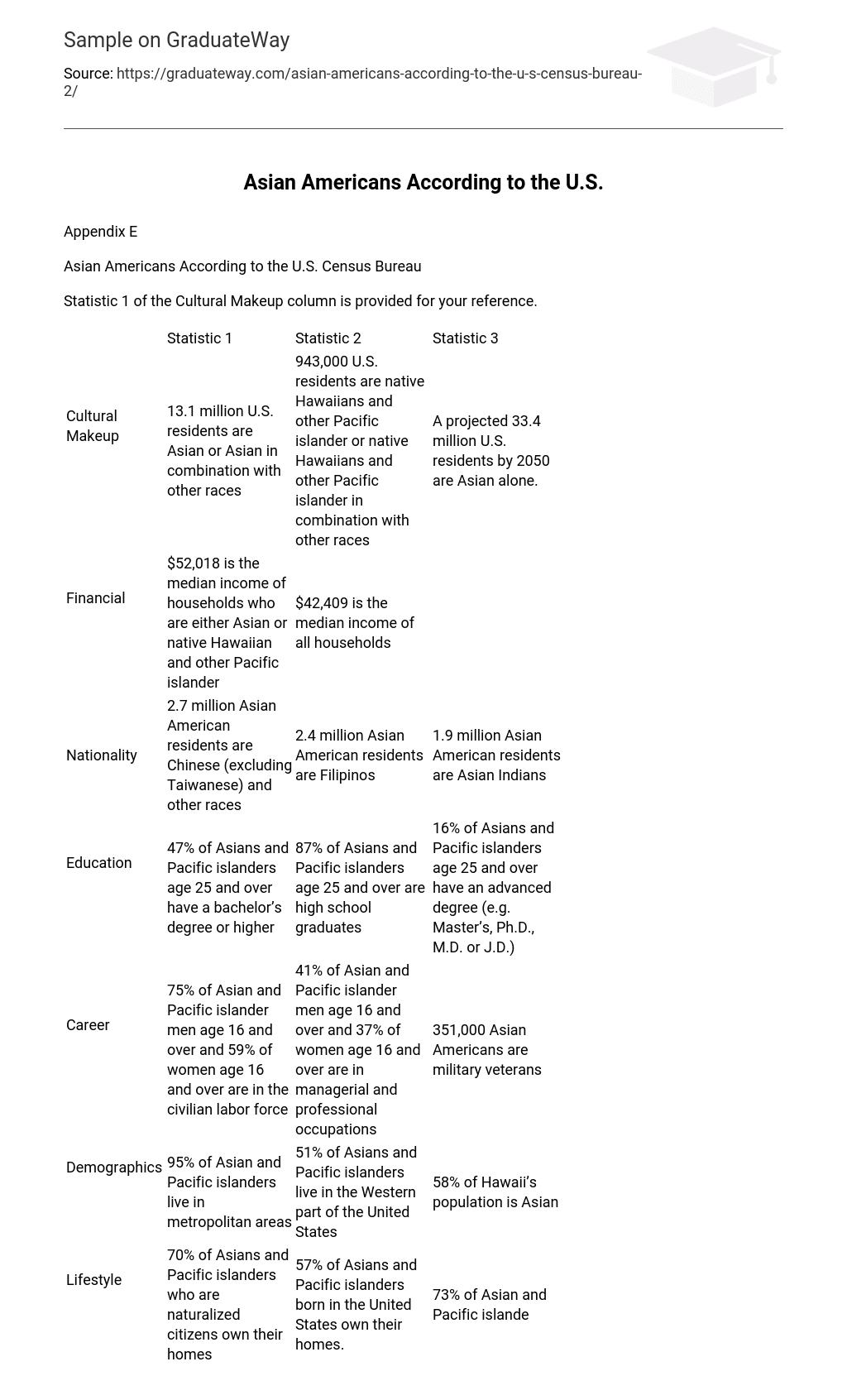Appendix E
Asian Americans According to the U.S. Census Bureau
Statistic 1 of the Cultural Makeup column is provided for your reference.
| Statistic 1 | Statistic 2 | Statistic 3 | |
| Cultural Makeup
|
13.1 million U.S. residents are Asian or Asian in combination with other races | 943,000 U.S. residents are native Hawaiians and other Pacific islander or native Hawaiians and other Pacific islander in combination with other races | A projected 33.4 million U.S. residents by 2050 are Asian alone. |
| Financial
|
$52,018 is the median income of households who are either Asian or native Hawaiian and other Pacific islander | $42,409 is the median income of all households | |
| Nationality | 2.7 million Asian American residents are Chinese (excluding Taiwanese) and other races | 2.4 million Asian American residents are Filipinos | 1.9 million Asian American residents are Asian Indians |
| Education
|
47% of Asians and Pacific islanders age 25 and over have a bachelor’s degree or higher | 87% of Asians and Pacific islanders age 25 and over are high school graduates | 16% of Asians and Pacific islanders age 25 and over have an advanced degree (e.g. Master’s, Ph.D., M.D. or J.D.) |
| Career
|
75% of Asian and Pacific islander men age 16 and over and 59% of women age 16 and over are in the civilian labor force | 41% of Asian and Pacific islander men age 16 and over and 37% of women age 16 and over are in managerial and professional occupations | 351,000 Asian Americans are military veterans |
| Demographics
|
95% of Asian and Pacific islanders live in metropolitan areas | 51% of Asians and Pacific islanders live in the Western part of the United States | 58% of Hawaii’s population is Asian |
| Lifestyle
|
70% of Asians and Pacific islanders who are naturalized citizens own their homes | 57% of Asians and Pacific islanders born in the United States own their homes. | 73% of Asian and Pacific islander households are made up of families |
These statistics reveal that the number of Asians living in America is expected to post a projected increase of 254.96% by 2050, or grow to an estimated number of 33.4 million residents who say that they are Asian alone, from the 2004 figure of 13.1 million residents who are Asian or Asian in combination with other races. The same statistics show that most of the Asian Americans are in the civilian labor force while some are working with the military.
Moreover, according to the Census Bureau statistics, Asian Americans are well educated. Majority of them are high school graduates with 47% of those over 25 years of age holding a bachelor’s degree and 16% have either a Master’s degree or a Ph. D. This is the most likely reason why the Asian households in America enjoy a higher median income of $52,018 compared to the $42,409 median income of all households. As a result of a higher median income, most of them (70% of naturalized citizens and 57% of those who were born in the country) own their homes. They are also city dwellers (95%) and many of them prefer to live in the Western part of the country (51%). Asians also show that they are family-oriented, with 73% of Asian and Pacific island households being made up of families.
Asian diversity in the United States is anticipated to strengthen with immigration. Since Asians are a family-oriented people, those who are now living in the country could be expected to do everything in order to get the rest of their relatives back home. Asians would boost the country’s economy by contributing more highly skilled and, therefore, highly productive workers, as shown by their penchant for education. Asian Americans have also shown their preference to have their own their homes. This attitude should be a shot in the arm for the housing industry in the country. Finally, being city dwellers, Asian Americans are expected to spur the growth of cities in the United States.
Reference
- U.S. Census Bureau. (2004, April 19). Asian Pacific American heritage month: May 2004.
- Retrieved December 1, 2004, from http://www.census.gov/Press-Release/www/releases/archives/facts_for_features_special_editions/001738.html





